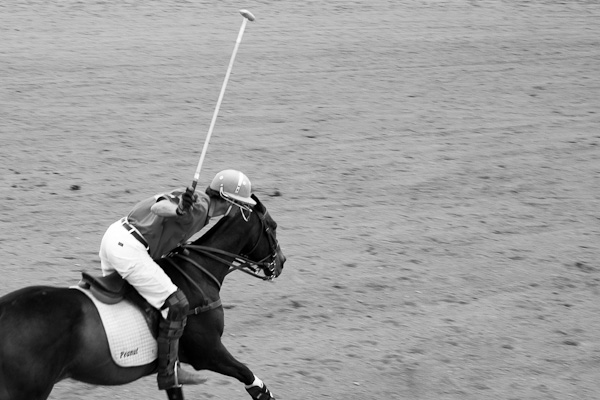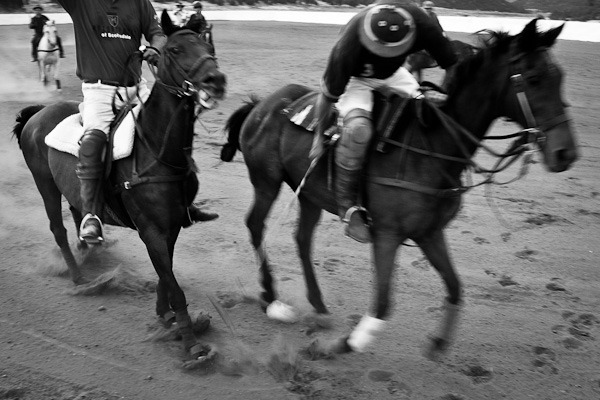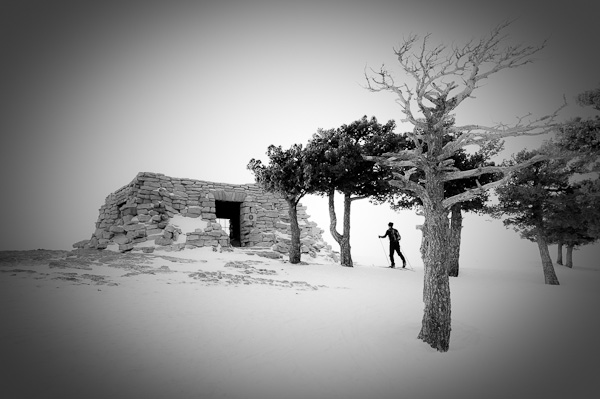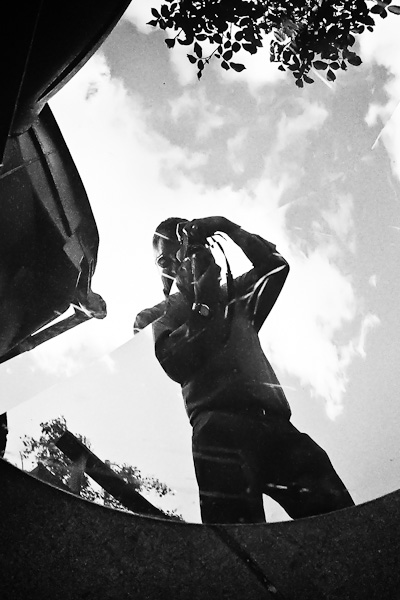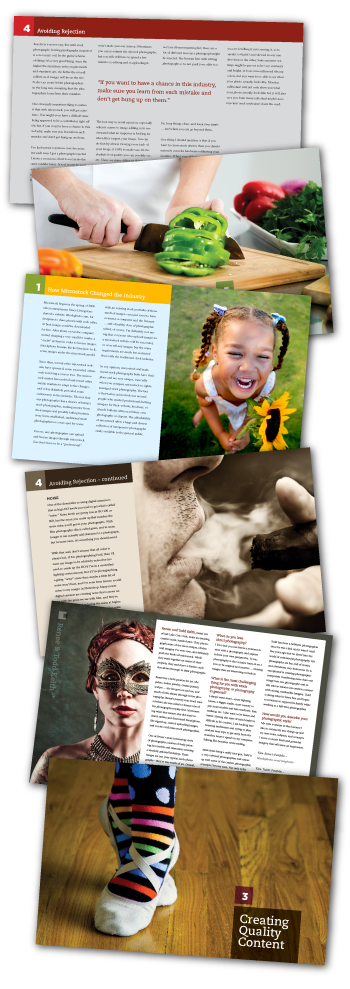I’m working on my series of images from the polo match I shot 4th of July weekend and have been dying to post some images but don’t want to give too much away. I’m hoping the series can stand on its own. However, I thought I might post an outtake. Here is Diego Flores riding Peanut during one of the chukkers.
Polo Teaser
As some of you know my wife and I were invited to visit a ranching friend of ours this past weekend and attend a polo match on his property. I’d never seen polo before and was unaware such a spirited and vibrant community existed in the state of New Mexico. Here is an image as a teaser of more to come. I took close to 800 frames while there so hopefully I can manage a decent photo-essay.
Turn Around and Photograph What Is Around You
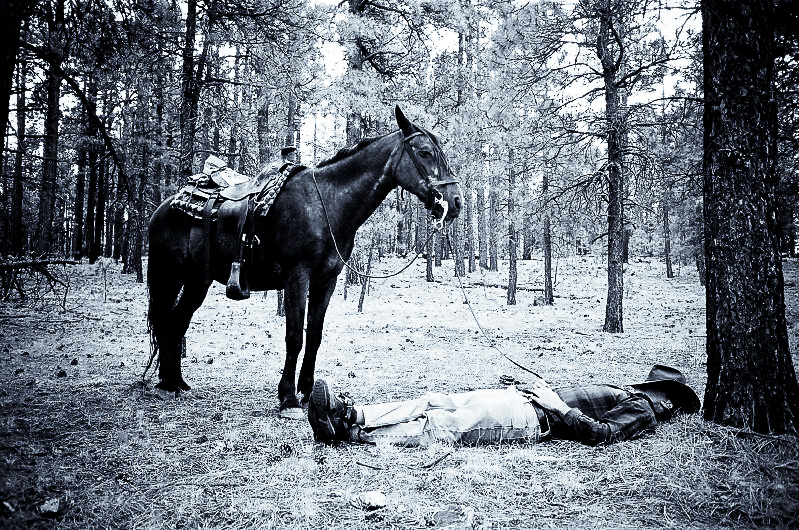
My horse, Cometa, and I nap in the middle of a long day. Photo courtesy of my wife, Ana Aragon de Miller
I have been watching other photographers, local friends mostly, as they move through their process in photography. Readers of this blog will recognize I’m particularly attracted to the creative process and how that works out psychologically. Watching my friends, and myself, struggle with the creative process in photography is endlessly fascinating for me. One struggle I have observed many of us go through is what I call, the “loss of subject matter” phase.
The process can go something like this: 1) the person gets enamored with images and image making; 2) the person becomes enamored with and buys a “good” camera; 3) they take pictures of everything and everyone; 4) eventually they get a bit better and become more selective about what they shoot; 5) they begin to grow disenchanted with their subject matter-it isn’t as interesting as it once was-it has been done before-it is old hat; 6) eventually they can feel like there isn’t anything local that they want to photograph and they need to travel to get that feeling back.
Not everyone experiences it in this way, but it is fair to say that many of us find the distant and unknown more exotic to photograph than the local and known. Henri Cartier-Bresson, that heralded pioneering photographer, once said,
“To interest people in faraway places-to shock them, delight them-is not too difficult. But the most difficult thing is in your own country. You know too much….when it’s your own block, with such a routine, it’s quite difficult to get. When it’s places I go to all the time-I know too much and not enough and to be lucid about it is the most difficult.”¹
And yet, who better to tell the local stories than those of us who live right here? Whether it is Howard County, Maryland or Albuquerque, New Mexico, or Lubbock Texas, stuff happens there, interesting stuff happens there. I will venture that if you start looking, really looking, you will find something interesting right where you are. David duChemin recently encouraged people to pass on buying new gear and put the money toward buying plane tickets. That is great advice. After all, it’s not in the gear that you will find great images. But it is also not really in photographing more exotic places that you will become a better photographer. Becoming a better photographer happens by seeing with newer and better eyes, and using the camera at hand to depict your vision of what is presented before you. What better place to start than in your own town?
Cartier-Bresson, in the quote above, said he knew “too much and not enough” about the places with which he was familiar. I know it is the same for me. How about you? What if we were to get curious about where we live? Can we really effectively tell the stories of distant lands when we cannot see and tell the stories of our own land?
What is it you don’t know enough about in your neck of the woods? What stories are there that are just begging to be told? Explore what you know about where you live and go deeper than you’ve gone before; explore what you do not know. Challenge your assumptions about your environment (yes, you do have them!) and look deeper at the people living there, their habits, their customs, their celebrations, their losses. What draws you in? What repels you? Provided you will be safe enough, can you explore those subjects that give you a negative reaction as well as those that you are attracted to? There is a landscape, a people (or several), a history, a culture, nature, in everyone’s home town; what is the visual story of that place.
Turn around, get curious about the place you live. It is fine to long for travel and adventure but, if you’re anything like me, you’ll spend most of your days at home. And I believe that is an interesting place. You are more qualified to tell that story than I am as I just past through and skim the surface.
PS. I got totally jazzed about photographing where I live after I started thinking in this way and, wouldn’t you know it, opportunities have begun presenting themselves to me. So, I’ve got a fun one in the works that I hope turns out. Stay tuned. I don’t want to give anything away but I’m really jazzed to photograph this.
PPS. Oh, and for some additional help with making photographs “close to home” check out Stuart Sipahigil’s wonderful ebook. Aptly titled “Close to Home”, it is available for purchase through the good folks at Craft & Vision.
¹. This quote is taken from this video featuring Henri Cartier-Bresson’s work and comments on it that was up on vimeo for a while but has since been taken down. The DVD is available on www.icp.org. The direct link to the video store page is here.
New Craft & Vision eBook: A Deeper Frame
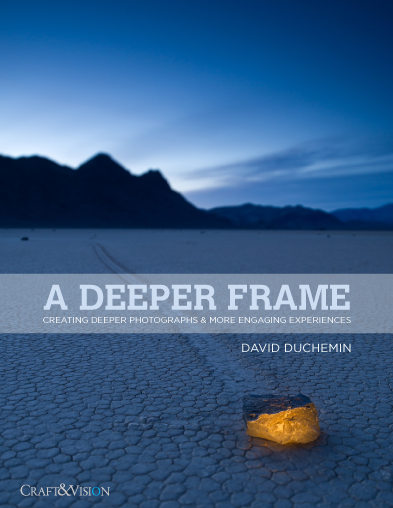 The fine folks at Craft & Vision, and especially David duChemin, have done it again with the release of today’s ebook “A Deeper Frame.” The books author, humanitarian photographer, and photography teacher tackles how to make images with a greater sense of depth.
The fine folks at Craft & Vision, and especially David duChemin, have done it again with the release of today’s ebook “A Deeper Frame.” The books author, humanitarian photographer, and photography teacher tackles how to make images with a greater sense of depth.
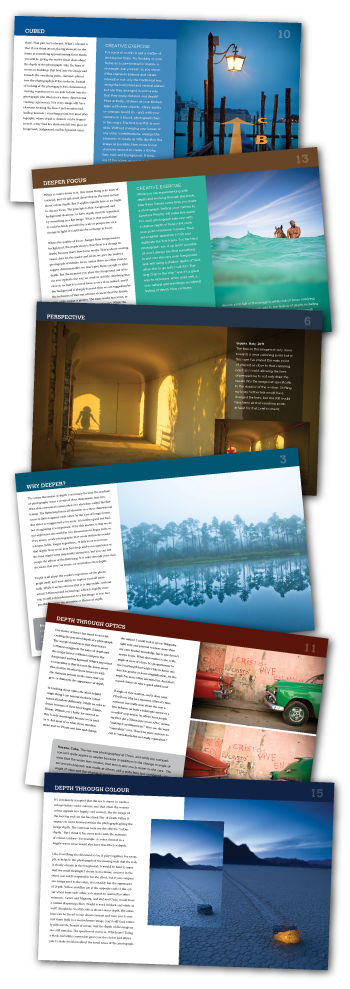 What I like about duChemin is that he appears to be a man of depth and substance and these qualities show through in this book. Not content to write strictly technical manuals, duChemin attacks depth through the use of perspective, optics, focus, colour, contrast, light, emotions, and my favorite, “cubing.”
What I like about duChemin is that he appears to be a man of depth and substance and these qualities show through in this book. Not content to write strictly technical manuals, duChemin attacks depth through the use of perspective, optics, focus, colour, contrast, light, emotions, and my favorite, “cubing.”
I tend to make it a point to read most of what duChemin writes and he did not disappoint. I am happy I read A Deeper Frame. He really gave me a number of things to think about and pay attention to as I move forward on my photographic journey. Of particular interest is how thinking of the frame as a cube rather than a rectangle will affect my future images. Clear and concise in delivery I think A Deeper Frame may just be one of the books that will push the limits of your photography and encourage you into a new realm of visual creativity, moving you from two-dimensional conversations to deeper, three-dimensional ones.
Twelve! Deeper Discounts than Usual
For the next five days only you can have A DEEPER FRAME for $4 (discount code DEEP4). Or you can buy 5 eBooks for the price of 4 (discount code DEEP20). Also, because this is David duChemin’s 12th eBook he is offering 12 eBooks for $40. That’s about 34% off the already ridiculous price. That’s $3.33/eBook! Use discount code DEEPER12 when you Visit Craft&Vision, fill your shopping cart and check out. These codes expires at 11:59pm PST July 2, 2011.
The Artist’s “Raison D’être”
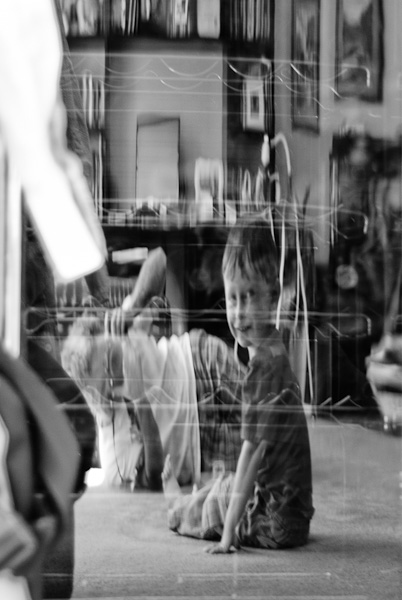 About a week ago I wrote a blog post about how I inspired someone through my art and I’ve been wrestling with what I really want to say about meaning. I’m not fully sure I’ve arrived at my thesis for this subject but I wanted to turn you on to something written by my electronic friend, Stuart Sipahigil, upon his return home from The Artist’s Roundtable.
About a week ago I wrote a blog post about how I inspired someone through my art and I’ve been wrestling with what I really want to say about meaning. I’m not fully sure I’ve arrived at my thesis for this subject but I wanted to turn you on to something written by my electronic friend, Stuart Sipahigil, upon his return home from The Artist’s Roundtable.
Pop on over here to read is post.
Apparently Stuart has found his “raison d’être”, his reason for being, his purpose while at that workshop. What a profound gift, that.
I should know. My day job is in the mental health field and I often find myself sitting with people who are suffering because they’ve lost their “raison d’être due to one reason or another. It can be a painful state.
The challenge then is to try to discover something that has meaning deep inside the person and this journey of discovery can be long an arduous. Stuart was fortunate that he was with some skilled and empathic friends who didn’t answer his questions for him, or relieve him from the hard questions. And out of the questioner came the answer. And what an answer!
How does this relate to creativity. Well, I believe that art that comes from a sense of purpose within the artist is more honest art; the artist creates their own personal work-their vision-when it has meaning, personal meaning, for them. And a good way to do that is to align their art with their personal purpose. After all, isn’t photography, as Henri Cartier-Bresson said, a way of screaming what you feel?
In Defense of Mindlessness
I was listening to a podcast recently where Matt Brandon was interviewing David duChemin. It was a wonderful interview. I find Matt to be a skilled interviewer, weaving his own opinions gently into the conversation with the interviewee and thereby making meaningful discussions worth listening to. Matt was fully engaged in this interview as well, as was David.
David appears to be a wonderful man and I have to say I have very much enjoyed reading his books, ebooks, and blog posts as he manages to be courageous enough to discuss those aspects of the photographic world that just rile him up. This interview is no different and I thoroughly enjoyed it.
During the course of the interview, while attempting to make a point, David mentioned that part of his goal is to encourage people to photograph more mindfully. And that got me thinking…
Now, before I start my rant, allow me this one disclaimer: I love mindfulness. I’ve studied Buddhist and Hindu forms of mindfulness training; I’ve applied it to my personal, professional, and spiritual life; I have to say that mindfulness has turned my life around and is responsible for its positive direction at this time. I’m all for it. I love it. And I understand and support what David is trying to do regarding how photographers photograph. But are we in danger of tossing mindlessness in the trash bin because it is the flip side of the mindful/mindless coin?
Now, another note before I continue: I think some defining clarity is in order. When I speak of Mindlessness I am using the term in a very specific way. Mindlessness to me is not Distractedness. Distractedness, as I define it, is the state of having our attention taken away from the present to something else: smartphones, iPads, TV, daydreaming, that sort of thing. Mindlessness, to me, is different from Distractedness in that it is the state of being fully present but not actively thinking. It is a state of being observant, aware, present, engaged, receptive, responsive.
To my way of thinking this is a state of openness and receptivity that should be highly prized in creative circles. Think “being in the flow” or “being in the zone.” Mindlessness is a state of effortless ease in the moment of great effort; a time of clarity in the midst of confusion. It is, I believe, the time when we are most receptive to the whispers of the muse. It is, therefore, a state worth cultivating.
But what of mindlessness? Is it getting a bad rap? Is it getting a rap at all? Is it even on the radar? The image above is my example of Mindless photographing. My friends and I had snowshoed out to this stone house on the summit ridge of the Sandia Mountains outside of Albuquerque and I had a good time making a few images of the house. I’d thought through my exposure settings and aperture settings; I’d visualized the final outcome of the image given the cloud we were in and the contrast between the snow, trees, and stone; I’d worked out and photographed from several vantage points. In short, I’d been mindful about photographing my subject. Finished with my images I’d put my camera in my pack and started to sling that pack onto my shoulders when I noticed the cross-country skier heading up to the house.
In that moment, with my pack half slung, I had a familiar feeling. It was a feeling just like the days, years earlier, when I raced bicycles full time: after all the training and analyzing of my competition, my gearing, my heart-rate, the wind, the terrain and we were whizzing down the race course, that a voice in my head both shouted and whispered “NOW!” When I listened to the voice I always ended up in the winning breakaway. When I didn’t listen I was left to watch that winning breakaway ride away from the main field of riders, leaving me to duke out the minor placings against a much larger contingent of riders.
“NOW” that voice whisper/screamed in my ear. For a moment I hesitated…almost too long. But that feeling, and my state of Mindlessness, allowed me to be responsive to what I can only consider the Muse. As I ripped open my pack, and the camera bag stuffed inside, I followed the skier with my eyes, “seeing” the image in my mind’s eye as it was beginning to take form in front of me. As the camera came up the aperture was set matching shutter speed to ensure good depth of field while freezing the action-all without thinking about it. He wasn’t slow, this skier, so only one moment was possible and when the right pose was struck at the right spot the exposure was made.
I’m quite sure I didn’t make this photograph. That came from somewhere else. While being in my Mindless place I allowed the Muse to work through me-or at least I didn’t hinder the process with my active mind.
It is an odd thing to trust this process. It takes a measure of courage to do so. After all, we’ve spent a lot of time and energy learning this craft. We’ve put countless hours into understanding exposure, aperture, composition, white balance, ISO settings. After all that time and conscious thought and effort to learn, understand, focus, and execute mindfully how do we trust that this explicit knowledge has somehow become implicit and will flow out of ourselves from a place in ourselves beyond thought. Surrendering to the Muse might be an uncomfortable idea for some, but I am making the argument now that this is a place and experience of great beauty and out of which much of what is true and honest about art and creativity is born. I am suggesting that we might give ourselves over to another force while making images Mindlessly. It might seem odd at first but after a few tries, when you feel the flow, you will know.
For more on the subject but perhaps with different words check out the latter section of Steven Pressfield’s book, “The War of Art” and Elizabeth Gilbert’s presentation on the muse at TED.com.
Listen to Matt Brandon’s interview with David duChemin HERE
Inspiration Mondays: Me(aning)
Normally during these occasional Inspiration Monday posts I give a short write-up about some photographer or artist that has moved me to continue this passion of photography. So it was with bemusement that I found myself recently on the other side of the coin artistically. It turned out I managed to somehow inspire someone else. Who knew!?
Carey O’Connell is the sister of a friend and colleague. Both Carey and Jennifer offered me the kindness of attending the gallery opening when a couple of my prints were hung a couple of months ago. We had a nice chat, talked some shop, exchanged business cards, that sort of thing.
As it is the 21st century, Carey and I did our networking thing through FaceBook and Twitter and Blogland. It turns out she is a writer and poet. Unknown to me she also poked around this website and browsed through my images until eventually I posted this image.
 Not long after I received an email from her, “I’ve been inspired by your photograph and want to write a poem for it. Do you mind?” Mind? Me? “Have at it” was my response, I believe. At least that is the story I have of it.
Not long after I received an email from her, “I’ve been inspired by your photograph and want to write a poem for it. Do you mind?” Mind? Me? “Have at it” was my response, I believe. At least that is the story I have of it.
She forwarded the poem to me for approval, a step not really necessary but quite kind, and soon the image and poem were on her blog. We tweeted about it and had some fun and then, not much later, another image and another poem. This time around this image taken during the Dia de los Muertos parade here in Albuquerque.
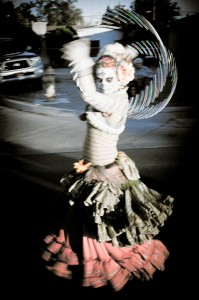 It is an odd and interesting thing to inspire someone else. For me it is easy to be inspired by others. They are so amazing and gifted and talented. From my point of view I try to make photographs I can relate to and I attempt to tell a story through either one image or a series. Sometimes I just post an image simply because I think it looks cool. But then, out of the viewer, comes an whole new story altogether. This is a fascinating process and I am endlessly interested in how people interpret images through the filter of their own personal meaning.
It is an odd and interesting thing to inspire someone else. For me it is easy to be inspired by others. They are so amazing and gifted and talented. From my point of view I try to make photographs I can relate to and I attempt to tell a story through either one image or a series. Sometimes I just post an image simply because I think it looks cool. But then, out of the viewer, comes an whole new story altogether. This is a fascinating process and I am endlessly interested in how people interpret images through the filter of their own personal meaning.
Some artists are dumbfounded at others’ interpretations of their work, but I find it exhilarating. Words and images; images and words. There is something wonderful about the place where these two artistic mediums connect and I look forward to more collaborations.
Now, wouldn’t it be wonderful and interesting to come up with an image to match someone else’s words?
You can read Carey O’Connell’s words on her blog, “The World Poetized“, as well as her book “The World Poetized, Vol. 1” in either analog or Kindle form. She’s also on twitter (@crosescribe) tossing Haikus into the interwebs.
Cracked: the Challenge of Too Much Creativity
I don’t know. Not many weeks ago I was wallowing in self pity as I waded through the morass of Resistance; no mojo, no drive, no direction. Motivation wasn’t even waxing and waning; it was simply waning. Today I find myself on the flip side of that coin.
And it’s not much better, really.
Oh, I know. Don’t get me wrong. If I were back in the morass I would be praying for the challenges I am facing at the moment. I might just have actually done so back then. I don’t remember. I was lost.
But today I struggle with a different “problem.” Too much motivation. Too many projects. Too many ideas. I feel pulled in too many directions photographically. I’m finishing up a project for my brother; I’m putting finishing touches on a photobook for my family (it is nearly a year overdue and I’ve another due in August!); I’ve begun a project based on my nephew’s high school baseball games; and this spurred me to start another project that I’m keeping quiet at the moment in order to experiment with working through an entire project without outside input.
So, I feel torn, pulled, distracted. Too many irons in the fire. It feels like the opposite of “too many cooks spoil the broth.” It’s more that there are too many pots going simultaneously on the stove so that I cannot concentrate effectively on getting one right.
Finally, however, I recognized my “problem” and pushed through delivering the proofs for my brother’s pictures. Now I can focus on getting that photobook done for my family. But wait, I have a really great idea….
New Craft & Vision eBook: (Micro)Stock: From Passion to Paycheck
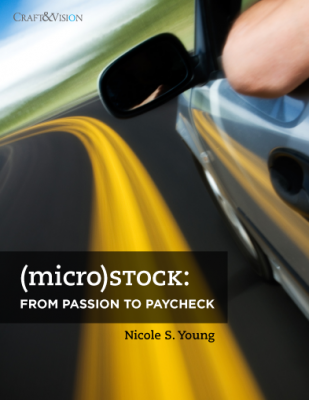 Regular readers of this blog, especially people that know me personally, are aware of how much I like eBooks. I’m a person that, while I love “traditional” forms of publishing for their handiness and physical beauty, just loves the paradigm change that the internet and digital media has brought to bear. The rapid and low-cost possibilities in publishing, as well as the democratization of the publishing process (and its return of control back to the artist/writer/musician) just excites me to no end.
Regular readers of this blog, especially people that know me personally, are aware of how much I like eBooks. I’m a person that, while I love “traditional” forms of publishing for their handiness and physical beauty, just loves the paradigm change that the internet and digital media has brought to bear. The rapid and low-cost possibilities in publishing, as well as the democratization of the publishing process (and its return of control back to the artist/writer/musician) just excites me to no end.
The same can be said for how photography has changed in recent years; now photography in general is more widely available through sites like Flickr, FaceBook, Twitter, Tumblr, and individual artist websites such as this one. In addition, what used to be a fairly exclusive club of professional stock photography and photographers has had its doors thrown open, making stock photography sales more available to a wider range of photographers.
I’ve dabbled a bit in stock photography and have managed to get a few images listed and sold through Getty Images, a worldwide leader in stock images. It has been great fun getting notices by email that an image of mine has sold, especially when I see the dollar signs attached. I start dreaming of new lenses, creating photobooks, buying stuff online or, more realistically, buying that next package of diapers…(You can view my modest collection of stock images listed on Getty here.)
But I, like others, have wondered if there is a living in this thing called “stock photography.” If I can make some money on one-off pictures I throw into the mix, could I increase my income significantly (read: high reward for low effort) by throwing more pictures into the mix. Well, to answer that question along comes a timely little eBook from my favorite photography eBook store: Craft & Vision.
(Micro)Stock: From Passion to Paycheck by Nicole S. Young is both a description and guide to succeeding in the stock photography industry. The book is filled with helpful pointers about the stock photography field in the digital age and also includes several case studies for additional reference. I enjoyed reading this book and I suspect if you are interested in stock photography or, like me, have dipped your toes into the business, you will like it too. It is not heavy on “how-to” and direction, but it does contain good examples of sell-able stock images as well as suggestions on what stock companies are looking for. There is a nice section on how not to be rejected as well. Ms. Young also maintains a realistic perspective throughout the book describing the work as rewarding but challenging and far from a get-rich-quick opportunity. Rather, she encourages photographers to enter to the stock photography business in an effort to improve their photographic skills and grow as an artist. The money you might make on the side just might be a nice little bonus. I know it is for me.
Special Offer on PDFs
For the first five days only, if you use the promotional code MICRO4 when you checkout, you can have the PDF version of (micro)STOCK for only $4 OR use the code MICRO20 to get 20% off when you buy 5 or more PDF ebooks from the Craft & Vision collection. These codes expire at 11:59pm PST June 11, 2011.
Put me in coach…
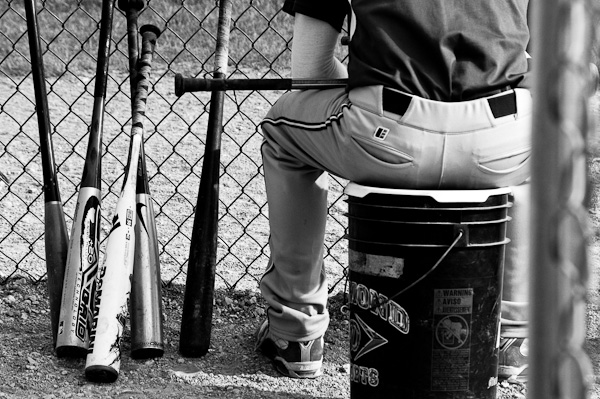 I’ve come to my brother’s house to witness my nephew graduate high school and along the way my brother roped me into photographing his production plant (hey-I do these kinds of things for free airfare!)
I’ve come to my brother’s house to witness my nephew graduate high school and along the way my brother roped me into photographing his production plant (hey-I do these kinds of things for free airfare!)
In addition, my nephew is quite the baseball player. Shortstop if you’re interested. And good enough to earn himself both a scholastic AND athletic scholarship to play baseball for Butler University. I’d never seen him play before so this weekend I had my opportunity to see two games and I took full advantage.
However, I’ve been encouraged by the recent push into visual storytelling that Rear Curtain has encouraged. And I had a great time watching Sabrina Henry work her way through a Magnum workshop recently where she worked with the subject of dogs. So I thought I might take on a little project while here and explore high school baseball. I don’t know how this will turn out, or if I got the shots I need to make this work in the short time allotted, but it is quite a fun challenge to try to piece together some sort of visual story out of this.
So this image is the first of the lot. It is one quickly processes to be a teaser and I hope it does the trick.

